Menus
- Top test Yamaha XT 1200 Z Super Tenere
- Technical specifications
- MOTORCYCLE measurements
- Brake measurement
- Noticed
- The cardan drive
- MOTORCYCLE rating
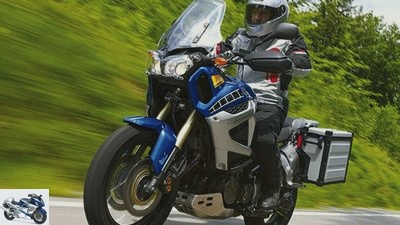
Bilski
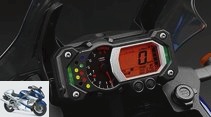
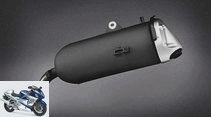
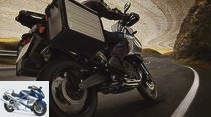
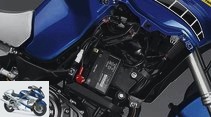
23 photos

Yamaha
1/23
The wheel speed sensors for ABS and traction control receive their signals from radially mounted rings.
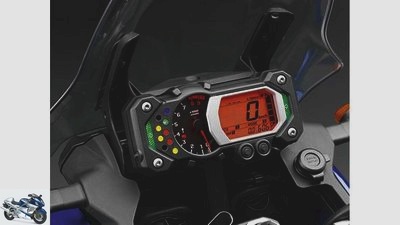
Yamaha
2/23
In the cockpit of the Super Tenere, numerous indicator lights and displays are gathered in a very small space.
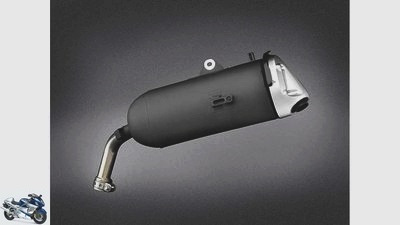
Yamaha
3/23
The stainless steel exhaust manifolds open into a large oval silencer made of plain steel with an aluminum cap.
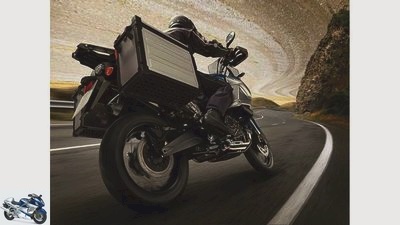
Yamaha
4/23
The exhaust gases are blown down to prevent the case from sooting.
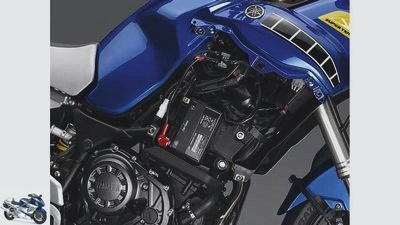
Yamaha
5/23
The battery, important electronic components and on-board tools can be found under the right-hand side panel.
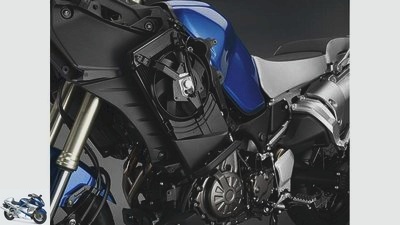
Yamaha
6/23
Air baffles concentrate the oncoming wind in the middle before it flows through the radiator on the left.
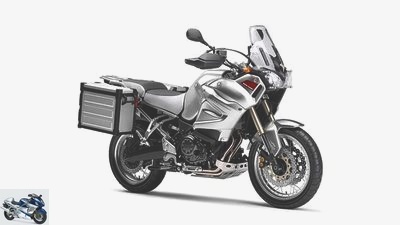
Yamaha
7/23
Blue has been the traditional Tenere color since the rally machines sponsored by Gauloises, and metallic silver is also available.
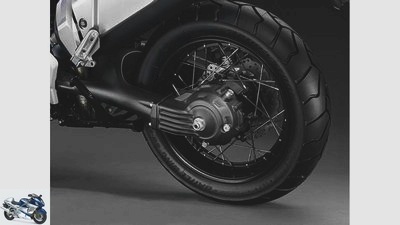
Yamaha
8/23
Long swing arm, compact rear axle drive. The cardan drive comes
without torque support.
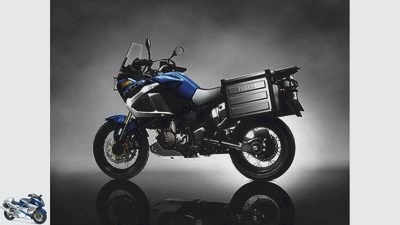
Yamaha
9/23
The travel enduro is powered by a two-cylinder in-line engine with 110 hp.

Yamaha
10/23
The Super Tenere is equipped with a case system, engine protection and protective goggles for the headlight lenses.
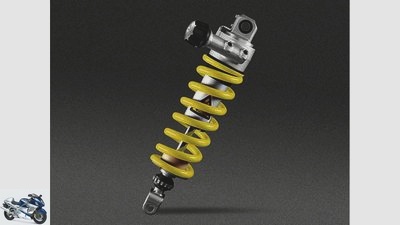
Yamaha
11/23
… compression and rebound are also adjustable.
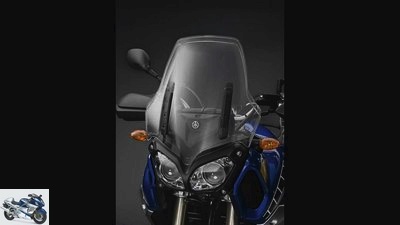
Yamaha
12/23
The height of the windshield is adjustable, a higher window is available at an additional cost.
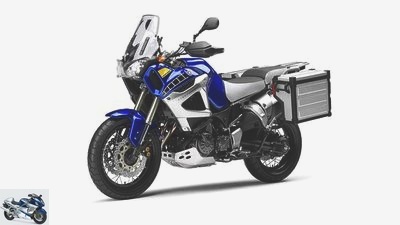
Yamaha
13/23
The Super Tenere should weigh 261 kilograms when ready to drive.
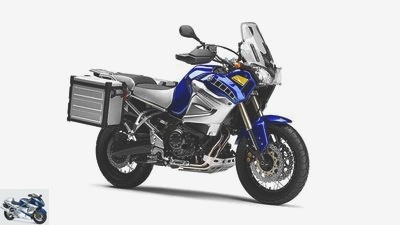
Yamaha
14/23
The Yamaha Super Tenere makes its debut as a special model "First edition".
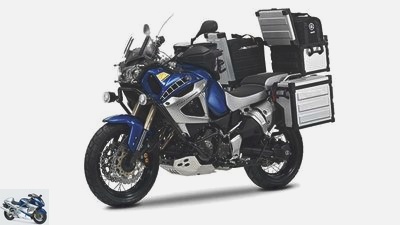
Yamaha
15/23
… are part of the special model "First edition".

Yamaha
16/23
The price: 14,750 euros plus additional costs.
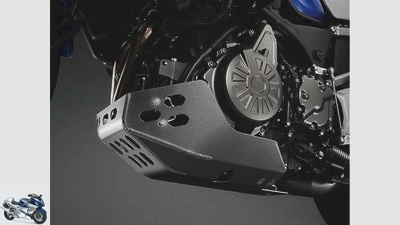
Yamaha
17/23
Motor protection and …
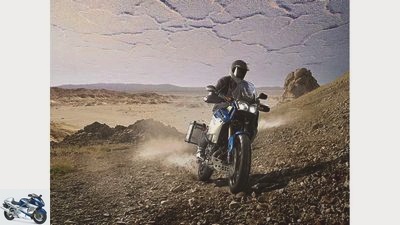
Yamaha
18/23
The exhaust runs from the right through the swing arm up to the left.
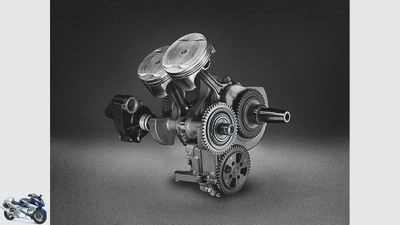
Yamaha
19/23
The concept is the same as that of the TDM 900 engine, but the 1200 has been completely redesigned.
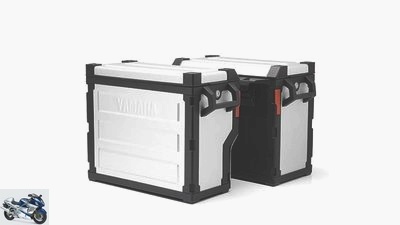
Yamaha
20/23
… the case system …
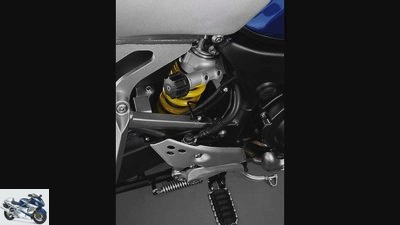
Yamaha
21/23
The spring preload can be varied using the handwheel …
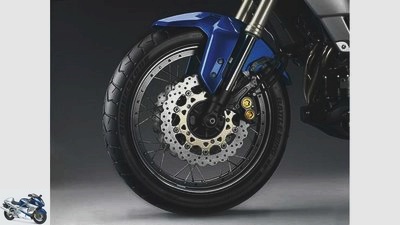
Yamaha
22/23
The Super Tenere rolls on elastic wire-spoke wheels with tubeless tires. Wave brake discs save weight.
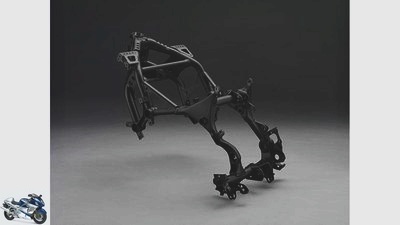
Yamaha
23/23
Pipes, cast and sheet metal parts made of steel were welded to form a purely functional frame.
Travel enduro in a single test
Top test Yamaha XT 1200 Z Super Tenere
The new edition of the Yamaha Super Tenere penetrates the territory of the BMW R 1200 GS. Can the massive desert ship of the queen compete for supremacy among the travel enduros?
R.under with the pounds. The inner values alone are of little use for the sporty appearance, the fighting weight and the well-trained figure must also be right. And with horse and rider. The steed, the eagerly awaited new Super Tenere, also has a major task to shoulder in this case: Due to its name, it has to be measured against the glorious rally past of the factory machines, but above all the comfort and equipment requirements of the Meet long-distance travel freaks. When looking at the new XT 1200 Z, the latter are likely to get bright eyes without exception: The design borrows from the outfit of earlier factory racers, the bulky appearance makes an impression, but aroused fears from the start that were confirmed on the MOTORCYCLE scales: The Super Tenere turned out to be quite difficult. 267 kilograms with a full tank of fuel (without suitcase) and the massive, towering tank-fairing combination do not suggest anything good in terms of maneuverability or even off-road capabilities.
Buy complete article
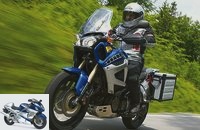
Travel enduro in a single test
Top test Yamaha XT 1200 Z Super Tenere
Yamaha is a real hit. In direct comparison to the BMW, the XT feels a bit more top-heavy, puts more pressure on the front wheel, which only minimally detracts from the unexpectedly refreshing maneuverability, but benefits the high cornering stability and clean straight-line stability at full throttle. Finely balanced, the Yamaha swings surprisingly fast through alternating curves, delivering reliable feedback from the front wheel and only tends to slide over the front wheel at brisk pace and at maximum lean angle (then the folding footrests put on).
Bilski
So big, so difficult and yet so fast on the top test course. The XT can even be athletic.
The comfortable basic set-up and the long suspension travel lead to a strong dip in the front and lots of movement at the rear when riding hard. A significantly increased preload of the fork and shock absorber as well as turned damping largely provide a remedy, which is reflected in the committed ride through the top test course in respectable times. This also helps on brisk country roads, especially since the fork’s responsiveness hardly gives rise to complaints – short bumps are dealt with properly, and rough braking maneuvers do not let the 43 mm upside-down fork bend helplessly. Which wouldn’t be surprising, given the force with which the four-piston calipers bite into the giant wave discs. Finely dosed (in contrast to the more radical acting all-or-nothing brake of the BMW), but vehemently decelerate the Yamaha stoppers and do not require a firm butcher’s hand. The standard combination brake acts on both wheels when the hand lever is pulled. However, if you first press the foot pedal, only the rear brake is activated – good for supporting braking when turning or in tight turns.
The Yamaha technicians have done astonishingly well with the ABS tuning: fine control intervals and the sensitive, not too brutal adjustment of the brake pressure guarantee overall deceleration at a high level without impairing driving stability. In other words, the Super Tenere achieves high deceleration values even on undulating surfaces without endangering stoic stability or even unsettling as the rear wheel rises. But not only the deceleration is electronically controlled, the slip when accelerating is also controlled by a computer fed by sensor data. The two-stage traction control (which can also be switched off) completely prevents the rear wheel from spinning in mode one and largely in mode two by changing the ignition timing, fuel supply and throttle valve position. The same applies here: The system regulates (in mode one) sensitively, reliably and almost unobtrusively. Anyone who wants to drift (and can do so) will switch off the TCS completely anyway.
Bilski
Traction control off, gas on – the heavy XT can easily handle light off-road fun.
Speaking of drifting: how does it start, the new engine? Was it worth the wait for the all-new 1200 with 110 hp? It has. The long-stroke twin accelerates super gently and smoothly even in sport mode (you practically never need the more moderate touring mode), direct, easy to calculate and dose, even if not as lively as a KTM-V2 or as brawny as that BMW boxer. With a dull bubbling, somewhere between TDM-Sound and Ducati-Ballern, the in-line two-cylinder with 270 degree crank pin offset takes on throttle smoothly from 1500 rpm, offers useful power from 2000 rpm and gives the XT driver a clearly noticeable increase in torque at 2500 rpm who pulls the driver’s arms up and the corners of his mouth up.
The twin, which is calmed down by two balancer shafts and runs almost vibration-free, increases steadily up to the measured maximum output of 107 hp at 7400 rpm, although in the upper area it noticeably lacks the bite that the BMW boxer delivers here. This is particularly evident when testing high-speed stability. Until the Yamaha breaks the 200 km / h sound barrier, it takes a long time (in contrast to the GS). Unlike the BMW, which is quite light at the front at high speeds and tends to stir, the Yamaha is always bolt-stable. Willfully initiated commuting subsides immediately.
The Super Tenere stoically pulls its course even at full throttle. A small masterpiece that will make the Bavarians wonder has been achieved by the Japanese with the cardan drive. Without complex shock absorbers or torque support, simply by cleverly designing the drive train including an incredibly long swing arm, Yamaha has achieved what cardan fans have always dreamed of: the maintenance-free shaft drive combined with the inconspicuous, trouble-free power transmission of a chain. No trampling, no rearing up when accelerating, no annoying load change reactions – that’s how it works.
If the precise, but bony hard and long shifting gearbox were to get some fine-tuning, the entire drive unit could be considered exemplary. The range that is suitable for travel can definitely claim this rating: Very low consumption and a large tank guarantee lush values of usually over 400 kilometers, which are important for trips to remote areas with a thin network of petrol stations. On the way there, even medium-sized drivers have to struggle with clear wind noises and slight tugging on their helmets, even with the windshield locked in the higher of the two levels. The windbreak cannot be considered perfect. The traction of the mounted Metzeler Tourance EXP tires is also rather modest off paved roads, on paved roads the grip and steering behavior are convincing.
The Super Tenere is more likely to be used in extended tours beyond Sweden or into southern Sicily than in the Moroccan mountains or in the eponymous desert. Yamaha wants to lure travel freaks who have tasted blood this year: The First Edition with standard aluminum cases, headlight protectors and aluminum engine guards will only be offered in 2010; from 2011 these features will cost a surcharge. A similarly equipped BMW R 1200 GS (with spoked wheels) is around 800 euros more expensive. But the Yamaha doesn’t really need this price argument. She is already taking her place next to the BMW on the throne – the days of GS sole rule are numbered.
Technical specifications
Bilski
Know where: behind the paneling are the battery and tool bag.
Engine:
Water-cooled two-cylinder four-stroke in-line engine, two balance shafts, two overhead, chain-driven camshafts, four valves per cylinder, bucket tappets, dry sump lubrication, injection Ø 46 mm, regulated catalytic converter, 600 W alternator, 12 V / 11 Ah battery, hydraulically operated multi-disc oil bath clutch, Six-speed gearbox, cardan, secondary ratio 2.987.
Bore x stroke 98.0 x 79.5 mm
Displacement 1199 cc
Compression ratio 11.0: 1
rated capacity 80.9 kW (110 hp) at 7250 rpm
Max. Torque 114 Nm at 6000 rpm
Landing gear:
Bridge frame made of steel, upside-down fork, Ø 43 mm, adjustable spring base, rebound and compression damping, two-arm swing arm made of aluminum, central spring strut with lever system, adjustable spring base, rebound damping, double disc brake at the front, Ø 310 mm, four-piston fixed calipers, disc brake at the rear, Ø 282 mm, two-piston fixed calliper, composite brake, ABS, electronic slip control.
Spoked wheels with aluminum rims 2.50 x 19; 4.00 x 17
110/80 R 19 tires; 150/70 R 17
Tires in the test Metzeler Tourance EXP "C."
Mass and weight:
Wheelbase 1540 mm, steering head angle 62.0 degrees, caster 125 mm, spring travel f / h 190/190 mm, permissible total weight 470 kg, tank capacity / reserve 22.6 / 4.2 liters.
Service data:
Service intervals 10000 km
Oil and filter change every 10000 km 4.2 l
Engine oil SAE 15W40, 20W40 or 20W50
Front fork oil Yamaha fork oil 01
Spark plugs NGK CPR8EB9
Idle speed 1100 ± 50 / min
front / rear 2.3 / 2.5 (2.3 / 2.9) bar
guarantee two years
Colours Blue, silver
price 14750 euros
Additional costs around 215 euros
MOTORCYCLE measurements
Drawing: archive
Power on the crankshaft. Measurements on Dynojet roller test stand 250, corrected according to 95/1 / EG, maximum possible deviation +/- 5%
The significant increase in torque from 2500 rpm is noticeable when driving, above which the engine increases its power evenly. At full load, the performance curves of Sport and Touring mode are congruent. The differences lie in the response behavior and in the partial load range (throttle valve opening), here the XT is much more tame in T mode.
Mileage
Top speed (manufacturer information): 210 km / h
Acceleration:
0-100 km / h 3.7 sec
0-140 km / h 6.9 sec
0-200 km / h 22.6 sec
Draft:
60-100 km / h 4.6 sec
100-140 km / h 5.1 sec
140-180 km / h 7.6 sec
Speedometer deviation
Effective (display 50/100) 46/95 km / h
Tachometer deviation:
Display red area 7800 rpm
Effective 7800 rpm
consumption:
at 130 km / h 5.0 l / 100 km
Country road 5.0 l / 100 km
Theor. Range of the country road 452 km
Fuel type super
Mass and weight:
L / W / H 2270/1000/1445 mm
Seat height 845-870 mm
Handlebar height 1170 mm
Turning circle 5150 mm
Weight with a full tank 267 kg
Payload 203 kg
Wheel load distribution v / h 50/50%
Brake measurement
Drawing: archive
Brake delay diagram of the Yamaha XT 1200 Z Super Tenere.
The XT 1200 Z is stable when braking. The control intervals are fine, the delay is at a high level. In view of the rather annoying long spring travel, 9.5 m / s² is a very good value.
Driving dynamics
Handling course I (fast slalom):
The Yamaha completes the fast slalom with great precision and stability. At the turning point, the response could be a little finer.
| Lap time | 20.5 sec | Reference Ducati Multistrada 1200 S |
19.9 sec |
| Vmax at the measuring point |
108.1 km / h |
| Reference Ducati Multistrada 1200 S | 108.0 km / h |
Handling course II (slow slalom):
The Super Tenere circles the course, slightly understeering. The traction control works well, the footpegs touching down prevent a better time.
| Lap time | 28.8 sec | Reference Ducati Multistrada 1200 S |
28.7 sec |
| Vmax at the measuring point |
53.9 km / h |
| Reference Ducati Multistrada 1200 S | 53.8 km / h |
Circular path (diameter 46 meters):
In a neutral inclined position, the XT 1200 Z also puts away the unpleasant parting lines without complaint. Here, too, the footrests that touch down prevent a better time. The chassis still had reserves.
| Lap time | 10.8 sec | Reference Ducati Multistrada 1200 S |
10.6 sec |
| Vmax at the measuring point |
51.3 km / h |
| Reference Ducati Multistrada 1200 S | 52.4 km / h |
Noticed
positive
- The main stand is not only standard, but also cleverly translated – the heavy chunk can be jacked up relatively easily.
- The mirrors on the wide arms offer a tremor-free and good view to the rear at any speed.
- The footrest rubbers keep the vibrations away from the seated driver. When driving off-road, they are pressed in and the boots are held securely on the serrated metal border.
negative
- The muffler is made of rust-prone, black painted sheet steel.
- The on-board tools must first be laboriously exposed: There is an Allen key under the seat, with which the right side panel can be unscrewed, behind which is the tool bag.
- The windshield can only be adjusted in height by fiddly loosening and moving four screws, rubber stoppers and plastic holders.
The cardan drive
Bilski
Looking under the cover of the cardan: The specialty of the hypoid toothing lies in the missing intersection of the axes (axis offset) and the compact dimensions.
The advantages of the cardan drive compared to the chain (clean, low-maintenance) have long been associated with disadvantages such as high weight, strong drive influences (load change reactions, strong compression and rebound, elevator effect). With the Super Tenere, Yamaha has managed to eliminate almost all of the disadvantages (apart from the weight), and this without major structural effort such as shock absorbers or torque support, and to build a cardan drive that drives unobtrusively like a chain drive.
Greater smoothness: The helical gearing runs quietly, but the high pressure on the tooth flanks requires a special, particularly high-quality gear oil.
MOTORCYCLE rating
Bilski
Place there: The Yamaha has a heart for passengers. The leg angle is more bearable than it looks here.
Conclusion:
The Super Tenere is probably a little heavy, but it’s also difficult to do. It embodies a comfortable, balanced travel machine with a powerful and cultivated engine. And impresses with its exemplary inconspicuous cardan drive and very effective brakes with excellently working ABS. The competition, especially the R 1200 GS, will have to dress warmly. Very warm.
Scoring
Category engine:
The flawless load change behavior is due to the grandiose, completely inconspicuous cardan drive. The smooth-running in-line two-cylinder does not lack power from the very bottom, but the somewhat long translation and the high total weight prevent better torque and acceleration values. Overall, the engine shows a more even, balanced than lively characteristics.
Category chassis:
The Yamaha pays for the praiseworthy cornering stability and the decent feedback from the front wheel with less playful turning and a little less maneuverability than some of its competitors. The successful balance allows the Super Tenere to fall relatively easily in an inclined position, and the extra weight on the front wheel contributes to the impeccable directional stability at high speeds. The chassis is rather softly tuned, but offers quite a variety of setting options.
Category everyday life:
The mighty tank holds 23 liters – in conjunction with the relatively low fuel consumption, it ensures an enormous range of well over 400 kilometers. A value worthy of a touring motorcycle. However, the very comfortably accommodated crew should reach their destination before dark, the headlights of the new 1200s only poorly illuminate the edges of the road and are neither particularly bright nor overly wide.
Category Security:
Brakes are for losers? No, whoever brakes like that wins. In fact, there are many points in the chapter Effect, controllability and ABS function. With a finely dosed, crisp bite and a sovereign and sensitively regulating ABS, the Yamaha leaves nothing to be desired. In general, the neutral, safe driving behavior is one of the great strengths of the Yamaha.
Category costs:
The favorable consumption and the laudably wide 10,000 inspection intervals allow the Super Tenere to come off well in the cost section. Two years guarantee is standard.
Overall rating: 694 out of 1000 points
Price-performance rating: 2.2
With 694 points, the Yamaha makes a great debut, but can also pay enough for what is offered at 14,750 euros.
Related articles
-
Yamaha XT 1200 Z Super Tenere: Enduro travel enduro in the long-term test
Image: Bilski 20 Images 1/20 The Yamaha XT 1200 Z Super Tenere doesn’t care about the goals: whether for camping in the Allgau, in a North German hotel or for …
-
Innovations Yamaha XT 1200 Z Super Tenere
Yamaha 23 pictures Yamaha 1/23 The wheel speed sensors for ABS and traction control receive their signals from radially attached rings. Yamaha …
-
Driving report: Yamaha XT 1200 Z Super Tenere
Mayer 23 photos Yamaha 1/23 The wheel speed sensors for ABS and traction control receive their signals from radially mounted rings. Yamaha 2/23 In the…
-
Comparison test BMW R 1200 RT, Yamaha XT 1200 ZE Super Tenere and KTM 1290 Super Duke GT
bilski-fotografie.de BMW R 1200 RT, Yamaha XT 1200 ZE Super Tenere and KTM 1290 Super Duke GT 1200 two-cylinder tourer in a concept comparison On the way …
-
Endurance test interim balance of the Yamaha XT 1200 Z Super Tenere
Photo: j.kuenstle.de 20 images 1/20 The Yamaha XT 1200 Z Super Tenere doesn’t care about the goals: whether for camping in the Allgau, in a hotel in northern Germany or for …
-
BMW R 1200 R, Kawasaki Z 800, MV Agusta Brutale 800 RR and KTM 1290 Super Duke R in the test
markus-jahn.com 35 pictures markus-jahn.com 1/35 BMW R 1200 R, MV Agusta Brutale 800 RR, Kawasaki Z 800 and KTM 1290 Super Duke R – It’s a shame that …
-
Comparison test BMW R 1200 GS Adventure and KTM 1290 Super Adventure
markus-jahn.com 46 pictures markus-jahn.com 1/46 KTM 1290 Super Adventure. markus-jahn.com 2/46 KTM 1290 Super Adventure. markus-jahn.com 3/46 BMW R 1200 …
-
Yamaha Tenere 700 in the top test
Arturo Rivas 21 images Arturo Rivas 1/21 The long-awaited and long-awaited Tenere 700 is finally here. Arturo Rivas 2/21 Fast times on asphalt …
-
BMW K 1600 GT and Yamaha XT 1200 Z Super Tenere in comparison
Henniges 17th photos Henniges 1/17 Comparison test BMW K 1600 GT and Yamaha XT 1200 Z Super Tenere. Henniges 2/17 Yamaha XT 1200 Z Super Tenere – travel…
-
Comparative test BMW K 1200 LT, Harley-Davidson Electra Glide Ultra Classic, Yamaha XVZ 13 TF Royal Star Venture Beautiful living Eating kilometers, for two, …